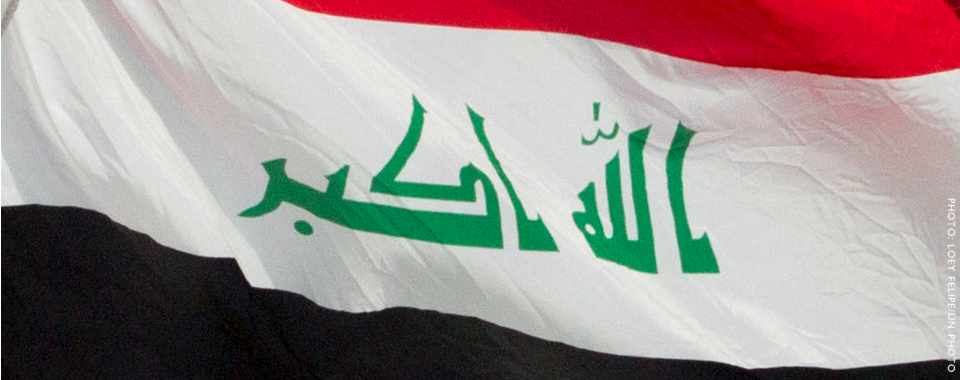BY NATE HAKEN AND SARAH COCKEY
Access to safe water has always been a fundamental driver of conflict around the world. The worst drought in hundreds of years preceded the Syria crisis in 2011 and fueled unrest in Yemen. Changing rain patterns and desertification have brought farmers and herders into lethal violence, killing over ten thousand in the last ten years in West Africa alone. Even the range wars in the American West in the 19th Century were largely over competition for water among the ranchers and farmers from Oklahoma to California. These conflicts are so old, they were even mythologized in the Bible with the story of Cain and Abel near the Euphrates River in modern day Iraq.

When the Fragile States Index (FSI) was first published in 2004, Saddam Hussein had just been executed and the U.S. was surging thousands of troops to stabilize a rapidly deteriorating situation following the U.S.-led invasion in 2003. Iraq was the fourth most fragile country in the world and was getting worse. The war was also reshaping the geopolitics of the entire Middle East and beyond, as regional powers were pulled in to defend their conflicting and overlapping interests, and locals fought for their lives and livelihoods. Since 2007, aside from a spike in violence between 2015-2017 when the Islamic State of Iraq and Syria (ISIS) emerged, the overall trajectory in Iraq has been positive. That positive trend, however, is increasingly at risk as donor fatigue has begun to kick in and many in the international development community are shifting their focus elsewhere. Yet a deeper look at the FSI indicators suggests that there remain serious areas of concern, that if not addressed in a focused and sustained way, could lead back into a vicious cycle of fragility and crisis.
There remain very real reasons for optimism, however. According to the FSI, several indicators have significantly improved in recent years, especially Security Apparatus and Economic Decline. ISIS’s decline in power has allowed the country to focus more on rebuilding its infrastructure and economy, which has been gradually improving due to a rise in crude oil production — which has nearly doubled over the past decade. The private sector is returning, as people open new restaurants, malls and cafes. Security has improved greatly. Every month, fewer civilians are killed. Iraq is now the most peaceful it has been in at least 16 years. Sectarian conflicts have decreased between Sunni and Shi’a populations, as people’s attention turns toward post-conflict reconstruction, governance, and public services. A promising agreement between the government of Iraq and the government of semi-autonomous Kurdish region has been reached regarding a 2020 budget sharing arrangement.
However, there are some indicators that have not improved, or have even worsened. Behind the deterioration of many of these indicators is the issue of public services, specifically water. Iraq has a history of an unstable water supply. Its main water sources, the Tigris and Euphrates rivers, flow from outside the country which puts very high stakes on transboundary water agreements and the technical implementation of those treaties, particularly given the series of dams Turkey built in the 1980s and a hydroelectric dam on the Tigris in 2019. The water issue has also been affected by changes in rainfall, exploitation of aquifers, and perhaps most notably the Iraq-Iran war and Gulf war, economic sanctions, and finally the U.S. invasion in 2003, all of which left a previously effective water management system in ruins. In short, there are years’ worth of damage that must be addressed for Iraq to recover and rebuild an effective system.
Although water quality is not a new issue, especially in the Basra region, it has become considerably worse since 2018 when around a hundred thousand Iraqis were hospitalized due to poor water quality. A lack of regulation and infrastructure has led to garbage and sewage contamination of the water supply, causing crop damage and impacting the livelihoods of farmers. Those wealthy enough resort to bottled water for cooking and drinking. Many promises have been made by the government to improve the situation, but projects have fallen through due to budgetary limitations and allegations of mismanagement.
Many of Iraq’s violent protests in the past few years have been largely related to the water crisis. In 2019, protesters began by demanding better access to water and electricity, but as numbers increased and demonstrators were angered by the lethal response employed by government security forces, the range of demands grew to include issues with corruption and grievances related to the sectarian government system.
Iraq has worked hard to emerge from decades of conflict into a new and promising era. However, the issue of water is key. If this critical issue is addressed, it will lead to improved health, livelihoods, and opportunity for the Iraqi people. But if it is not, then the spread of water-borne disease and further water-related conflict will only worsen. Iraq could lose the ground it has gained and be pulled back into a vicious cycle. Even as Iraq disappears from the front pages of newspapers, development and humanitarian actors must not forget that there is vital work still to be done.
